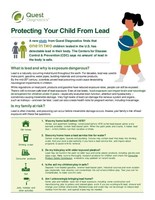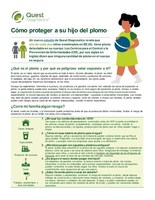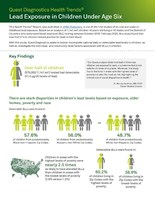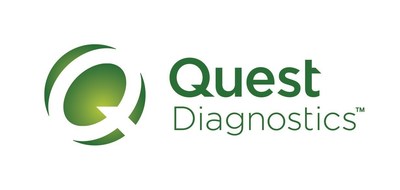-
pdf
-
pdf
-
pdf
SECAUCUS, N.J., Sept. 28, 2021 /PRNewswire/ -- One in two (50.5%) American children under six years of age tested have detectable levels of lead, a toxic metal, in their blood, according to a new Health Trends® study from Quest Diagnostics (NYSE: DGX) released today and published in JAMA Pediatrics. Young children living in areas with the highest percentages of pre-1950s housing and low incomes were most at risk.
The study by investigators from Quest Diagnostics and Boston Children's Hospital is based on analysis of de-identified laboratory tests performed by Quest on 1,141,441 children under 6 years of age living in 50 states and the District of Columbia who had lead blood testing during the study period, October 2018 to February 2020. Most (71%) of the children were between the ages of 0 and 2.9 years.
With this study, Quest Diagnostics seeks to bolster incomplete national data on childhood lead exposure and investigate the individual- and community-level factors associated with blood lead levels (BLLs) in children. It is the first study of its size and scale to examine BLLs as low as 1.0 µg/dL, which the researchers deemed "detectable" BLL. In the United States, an "elevated" BLL is typically identified as ≥5.0 µg/dL, although there is no known threshold for lead-based health effects.i
While the researchers found that a little more than half of the children tested (50.5%) had a BLL of ≥1.0 µg/dL (detectable BLL), 1.9% had elevated BLL of ≥5.0 ug/dL, a more than 36% decline from the 3% identified with BLL at this level in a Quest study published previously in the Journal of Pediatrics based on data from 2009-2015.
Still, the new Quest analysis reveals that the majority of American children have been exposed to lead, despite decades of public policies to reduce lead poisoning. A neurotoxin that causes irreversible health effects, including lower IQ, lead is found in many settings, including older homes, water pipes, and areas with heavy industry, as well as some consumer products. "No safe level of lead exposure in children has been identified," according to the CDC.
"The findings from this study underscore the urgent need to eliminate all sources of lead exposure from US children's environments," said Philip J. Landrigan, MD, MSc, Program for Global Public Health and the Common Good, Global Observatory on Pollution and Health, Boston College, Boston, Massachusetts and David Bellinger, PhD, MSc, Department of Neurology, Harvard Medical School, Boston, Massachusetts and Department of Environmental Health, Harvard T.H. Chan School of Public Health, Boston, Massachusetts in an editorial in JAMA Pediatrics.
"Our Quest analysis finds that while exposure to the highest levels of lead has declined in recent years, most American children are exposed to lead, a substance that is not safe for children at any level. Moreover, our analysis finds that kids in areas with the highest rates of poverty are also the most at risk, highlighting the critical role of social disparities in health," said co-author Harvey W. Kaufman, M.D., Senior Medical Director and Head of the Health Trends Research Program for Quest Diagnostics.
"Public health authorities have worked commendably to reduce lead exposure for decades, and yet, substantial risk remains. Our study is a cautionary tale of the enormous challenge of remediating environments following contamination with toxins dangerous to human health," Dr. Kaufman added.
To develop the study, the investigators combined the laboratory analysis with U.S. Census, Zip Code and other data to identify demographics trends and associate them with BLL.
Among the key findings:
Income and housing age associated with lead exposure
- Among children living in Zip Codes with the highest levels of poverty, 60.2% had detectable BLL, compared to 38.8% of those in areas with the lowest levels of poverty, a difference of 21.4%.
- Children in areas with the highest levels of poverty were nearly 2.5 times as likely to have elevated BLLs than children in areas with the lowest levels of poverty (2.9% versus 1.2%).
- Children with public insurance (Medicaid) were nearly twice as likely to have detectable BLL and only slightly more likely to have elevated BLL, as compared to those in a private health plan.
- For children living in areas with the highest levels of pre-1950s housing, 57.2% had detectable levels of lead compared to 42.6% for those with the lowest level of pre-1950 housing, a difference of 14.7%. Children in areas with the highest levels of pre-1950s housing had a nearly four-fold higher risk of elevated BLL than those with the lowest levels (3.5% versus 0.9%).
Higher BLL found in children in Zip Codes with predominately Black non-Hispanic populations
- 57.6% of children from predominately Black non-Hispanic Zip Codes and 56% of children from predominately Hispanic non-White Zip Codes had detectable BLL compared to 48.7% from predominately White non-Hispanic Zip Codes.
- 2.5% of children from Black Zip Codes had elevated BLL, 2.0% of those from White Zip Codes and 1.1% of those from Hispanic Zip Codes had elevated BLL.
Striking differences in BLL by state*
- Twenty-four states had levels of detectable BLL above the total population rate of 50.5%. Among these, Nebraska had the highest percentage, with 83% of children showing detectable BLL, followed by Missouri (82%), Michigan (78%), Iowa (76%), and Utah (73%).
- Six states – primarily in the rust belt – had elevated BLL more than double the national rate (1.9%): Nebraska (6.0%), Ohio (5.2%), Pennsylvania (5.0%;), Missouri (4.5%), Michigan (4.5%), and Wisconsin (4.3%).
No Safe Level for Lead in Children
Lead has no biological role in the body. Any detectable lead level is abnormal and potentially harmful, particularly in young children – and associated with adverse effects such as brain and nervous system damage, slowed growth and development, learning and behavior problems, and hearing and speech problems. While lead exposure's health effects are typically permanent, dietary measures and, in some cases, medical treatments, can help reduce potential damage.
"Given the lack of a threshold for the deleterious effects of lead in children and largely permanent effects of poisoning, prevention is extremely important. This means limiting exposure and testing of young children blood tested for lead – and having them retested periodically if results indicate a potentially unsafe level," said co-author Jeffrey Gudin, M.D., Senior Medical Advisor, Prescription Drug Monitoring, Quest Diagnostics. "Lead exposure isn't always apparent. That's why testing is critical."
"Over the past 45 years, blood lead levels overall have declined because of successful policies aimed at controlling lead in the environment, including its elimination from gasoline, paint, plumbing fixtures, and consumer products," said study author Marissa Hauptman, M.D., MPH, FAAP, Associate Director, Pediatric Environmental Health Center and the Region 1 New England Pediatric Environmental Health Specialty Unit, Boston Children's Hospital. "As a result, millions of children have been spared from the very high BLLs, once ubiquitous in the U.S. This study demonstrates, however, that despite this lead exposure is still ubiquitous in our environment, disproportionately affecting certain populations."
The full study, Individual and Community Factors Associated with Detectable and Elevated Blood Lead in US Children: Results From a National Clinical Laboratory, is available at URL. Quest Diagnostics also encourages concerned parents and communities to visit the CDC website.
Methodology
This cross-sectional, retrospective study analyzed de-identified results from blood lead tests performed at a large clinical laboratory October 2018-February 2020. The study analyzed pediatric BLL abstracted from the Quest Diagnostics Health Trends database, with data from 1,141,441 children <6 years old living in 50 states and the District of Columbia who underwent blood lead testing during study period. Children with lead testing of unknown source (n = 7,508) or with elevated BLL (≥ 5.0 µg/dL) who received capillary blood lead testing without confirmatory venous testing (n = 1,999) were excluded. Sex, age and insurance type were part of the laboratory analysis. The Quest Diagnostics research team also overlayed the laboratory analysis with U.S. census data to determine community-level demographics, including age of housing stock, poverty-to-income ratios and race/ethnicity. The researchers examined areas based on proportion of housing stock from before 1950; while lead paint was banned nationwide in 1978, some cities had begun to limit lead-based paint and paint produced after the 1950s tended to have lower concentrations of lead than that produced earlier. Paint can chip or be carried in dust, which children may eat or inhale.
*Only states with results from at least 500 children were included in the state-geographic analysis. Differences in state testing requirements may contribute to variable results seen between states.
Study Strengths and Limitations
The study's strengths are its size and national scope; the ability to examine narrow sub-groupings of data based on Zip Codes; and the use of an objective laboratory method, versus surveys or polls, which may be subject to user misrepresentation or error. Study limitations include reliance on testing orders, rather than population sampling; varying volumes of test results in certain states; and the inability to determine values below the threshold of detection. Quest Diagnostics does not provide services to all clinicians in the U.S., so results are not broadly representative of all patients tested in the U.S. Most tests were based on venous blood draws, which are often used to confirm prior test results by capillary, so some bias may be found in the findings. Based on analysis of de-identified test results, the study was performed in compliance with applicable privacy regulations and the company's strict privacy policies, and was determined to be exempt from Western Institutional Review Board.
About Quest Diagnostics Health Trends®
Quest Diagnostics Health Trends® is a series of scientific reports that provide insights into health topics, based on analysis of objective clinical laboratory data, to empower better patient care, population health management and public health policy. The reports are based on the Quest Diagnostics database of approximately 60 billion de-identified laboratory test results, believed to be the largest of its kind in healthcare. Health Trends has yielded novel insights to aid the management of allergies and asthma, COVID-19, clinical and workforce drug testing, diabetes, Lyme disease, heart disease, influenza and workplace wellness. Quest Diagnostics also produces the Drug Testing Index (DTI)™, a series of reports on national workplace drug positivity trends based on the company's employer workplace drug testing data. Quest Diagnostics Newsroom - Health Trends®
About Quest Diagnostics
Quest Diagnostics empowers people to take action to improve health outcomes. Derived from the world's largest database of clinical lab results, our diagnostic insights reveal new avenues to identify and treat disease, inspire healthy behaviors and improve health care management. Quest annually serves one in three adult Americans and half the physicians and hospitals in the United States, and our 50,000 employees understand that, in the right hands and with the right context, our diagnostic insights can inspire actions that transform lives. www.QuestDiagnostics.com
i Advisory Committee on Childhood Lead Poisoning Prevention. Low Level Lead Exposure 355 Harms Children : A Renewed Call for Primary Prevention Advisory Committee on 356 Childhood Lead Poisoning Prevention.; 2012.
SOURCE Quest Diagnostics




